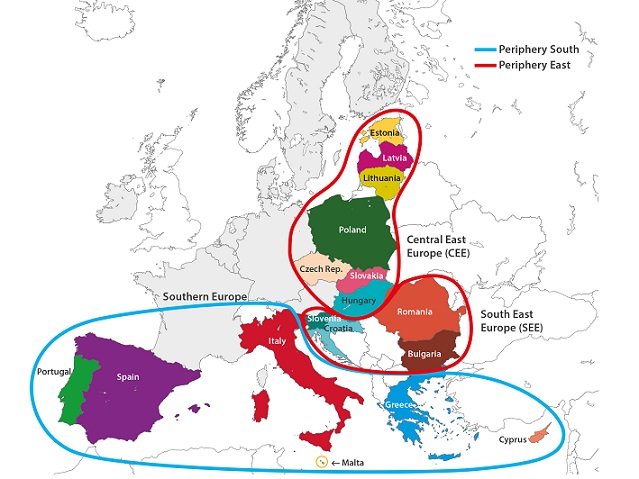transform! europe presents a comparative study on the economic, political, and ideological aspects of peripherality within the European Union.
Please find the eBook on the left/below (mobile version) in ‘Documents’ (English, PDF).
The study is based on the interdisciplinary approaches taken from economics, political science, sociology, and history. It pays attention to the interplay between the economic system, the political sphere as well as the cultual and ideological dimension of peripherality. The core and periphery dynamics represent a perspective that analyses power inequalities and dependencies. The study focuses on two peripheries in the European Union: Southern Europe (the South), as well as Central Eastern and South-East Europe (the East) – i.e., 17 EU Member States. The key aim is to understand how core-periphery dynamics shape the EU.
Overview – Mapped EU Peripheries

The study shows that both EU peripheries share a dependent position in terms of capital, investments, and technologies. These dependencies develop within differently structured economies. The economies of the southern European countries, faced with the crisis of the 1970s, halted or prematurely slowed down the process of industrialisation. In the years that followed they took the path of financialisation and hypertrophisation of the service and the public sector. The competition from the Eastern periphery, whose expansion in the production of intermediate goods for the German manufacturing industry partially displaced southern suppliers, contributed to the further weakening of the already fragile production base in Southern Europe. In this way, the incorporation of one periphery in the EU contributed to the decreasing economic development of the other. Looking at the Eastern EU periphery, even the industrial development of the most dynamic Central Eastern European countries (mainly the Visegrád Group: Czech Republic, Hungary, Poland, and Slovakia) is based on mono-specialisation in the automotive sector, which, in turn, is tightly integrated into the German value chain. On the other hand, the development of less dynamic Eastern European countries reflects, to some extent, vulnerabilities that are similar to those encountered in the Southern periphery.
In the political sphere, we can observe several problems related to peripherality. The party system and political conflict lines have been greatly influenced by the economic crisis in 2008 in both peripheries. However, whereas the East has witnessed a strengthening of populist right-wing political forces with a strong emphasis on identity issues and ‘welfare chauvinism’, we have seen the rise of new left-wing political options in Southern Europe. The rise of right-wing parties in these countries has been ‘delayed’ and remains with relatively limited power, due to the strong position of the left in the region. Italy represents an outlier nation, with a strong right-wing movement and a marginalised left.
Despite these regions being part of the EU’s periphery, the different economic needs and policy constraints pose serious obstacles for a common alliance to emerge between them. However, both peripheries seem to be eager to create alliances with Germany and France on major political issues. The dimension of representation in EU institutions reveals (partly) the peripheral status of the East and the South. Both EU peripheries are underrepresented in the EU institutions, which are still dominated by the core countries (esp. Western Europe). In the case of the Eastern periphery, the study notes massive underrepresentation in EU institutions, with the exception of the European Parliament.
When focusing on the cultural and ideological dimension of peripherality, the research shows that Southern, Central Eastern and South-East Europe have been construed as the Others, with the help of Orientalist stereotypes.
Hundred Shades of the EU. Mapping the Political Economy of the EU Peripheries
by Giuseppe Celi, Valentina Petrović, Veronika Sušová-Salminen
edited by Tatiana Moutinho, Dagmar Švendová
commissioned by transform! europe
eBook | ISBN 978-3-903343-16-0
259 pages | March 2022
Please find the Executive Summaries on the right/below (mobile version) in ‘Documents’ (PDF, English, Portuguese, Greek, Hungarian, Lithuanian, Bulgarian, Czech, Italian, Polish, German, Romanian, and Spanish).
Translations of the Executive Summary in SH will soon be available.
Hundred Shades of the EU — Study Presentation
Speakers:
Veronika Sušová-Salminen, Senior researcher responsible for the Central East Europe countries group. MA in comparative history, Ph.D. in Anthropology /Charles University in Prague; Specialisation: history and politics of modern Central and Eastern Europe, Russia and post-soviet space; works as researcher at the Centre of Global Studies (Institute of Philosophy of the Czech Academy of Sciences) and as editor-in-chief of webzine !Argument.
Giuseppe Celi, Senior researcher responsible for the Southern Europe countries group. Italian economist, currently Associated Professor of Economics in the University of Foggia. Coordinator of the Ph.D. Programme in Economic Theory at the University of Foggia and Italian Coordinator of the MA Programme Erasmus Mundus Economics of International Trade and European Integration. Recently published, together with other authors, the book Crisis in the European Monetary Union. A core-periphery perspective.
Valentina Petrović, Senior researcher responsible for the Southern Eastern countries group. Ph.D. candidate at the SPS Department at the European University Institute in Florence. Postdoc at the Department of Sociology at the University of Zurich.
Moderation:
Tatiana Moutinho, facilitator of transform! europe in the programme “Cooperation Strategies for Southern Europe”;
Dagmar Švendová, facilitator of transform! europe in the programme: “Central and Eastern European Strategy”;
Hundred Shades of the EU — Table of Contents
List of abbreviations
List of figures
List of tables
Preface, Tatiana Moutinho, Dagmar Švendová
Executive summary, Giuseppe Celi, Valentina Petrović, Veronika Sušová-Salminen
Key findings
Policy implications
Overview – Mapped EU Peripheries
Introduction, Giuseppe Celi, Valentina Petrović, Veronika Sušová-Salminen
1. The EU and geographies of capitalism in Europe from a historical perspective
2. Neoliberal globalization and Europeanisation
2.1 From the Keynesian era to the neoliberal globalization
2.2 Europeanisation and core-periphery relations in Europe
3. Conceptualization, research questions and methodology
3.1 Terminology and concepts
3.2 Problem statement and research questions
3.3 Methodological criteria and indicators
4. Structure of the study
PART I
Chapter 1 – Southern Europe (SE – Spain, Italy, Portugal, Malta, Greece, Cyprus), Giuseppe Celi
1.1 Introduction
1.2 Structure of the economy
1.3 Debt, taxation and FDI
1.4 Labour market and socio-economic conditions
1.5 International trade
1.6 Concluding remarks
Appendix
Chapter 2 – Central Eastern Europe (CEE – Czech Republic, Hungary, Slovakia, Poland, Estonia, Latvia, Lithuania), Veronika Sušová-Salminen
2.1 Introduction
2.2 Structure of the economy
2.3 Debt, taxation and FDI
2.4 Labour market and socio-economic conditions
2.5 International trade
2.6 Concluding remarks
Appendix
Chapter 3 – South-East Europe (SEE – Bulgaria, Croatia, Romania, Slovenia), Valentina Petrović
3.1 Introduction
3.2 Structure of the economy
3.3 Debt, taxation and FDI
3.4 Labour market and socio-economic conditions
3.5 International trade
3.6 Concluding remarks
Appendix
Chapter 4 – Trade networks and value chains, Giuseppe Celi
4.1 Introduction
4.2 The network of European trade between core and periphery
4.3 Trade in value added
4.4 A focus on the automotive industry in Europe
4.5 Conclusions
Chapter 5 – Comparison of the EU peripheries, Giuseppe Celi, Valentina Petrović, Veronika Sušová-Salminen
5.1 Contextual comparison: historical discontinuities vs. continuities
5.2 A comparison of the contemporary economic models
5.3 Global financial crisis and its impacts – convergence and divergence trends in ther peripheries
5.4 Dependent development and dependencies in the South and the East of the EU
PART II
Chapter 6 – The political manifestation of the core-periphery divide in the EU, Valentina Petrović, Veronika Sušová-Salminen
6.1 Introduction
6.2 The concept of cleavages and the left-right dimension
6.3 The cleavage structure in the Western political space
6.4 The cleavage structure in Europe’s periphery
6.4.1 Cleavage structure in Southern Europe
6.4.2 Cleavage structure in Central Eastern Europe
6.4.3 Cleavages in South-East Europe
6.4.4 Summary and comparison
6.5 Divergent positions in funding and migration policy
6.5.1 Funding policy in the EU
6.5.2 Migration policy: divergent interests between Eastern and Southern Europe
6.6 Coalition potential: what are the possibilities for cooperation between the Eastern and Southern regions?
6.7 Representation of Southern and Eastern peripheries in EU leadership
6.8 Conclusions
PART III
Chapter 7 – (Mis)representation and subalternity: discursive peripheralization in the hegemonic narratives of the core (and periphery), Veronika Sušová-Salminen
Introduction: peripherality and alterity in the imaginative geography of Europe
Case study 1: From Division to Di-Vision. Discursive strategies of the EU accession process
After the EU enlargement
Case Study 2: Beyond economy: othering and culturalization of the crisis in Greece
Greece and its peripherality
We, the hardworking and responsible – they, the lazy, corrupt Greeks
The crisis in ‘Northern/Western’ eyes
Comparison and conclusions
Conclusions and policy implications, Giuseppe Celi, Valentina Petrović, Veronika Sušová-Salminen
1. Introduction
2. The eyes of history: chronology and geography
3. Key findings: what are the key characteristics of the EU peripheral countries?
3.1 The socio-economic dimension
3.2 The political dimension
3.3 The cultural and ideological dimension
4. What is to be done?
4.1 Is there an alternative to austerity in the face of crises?
4.2 Policy implications
Endnotes
Bibliography
Glossary
Biographies
